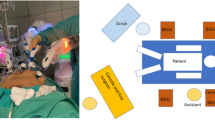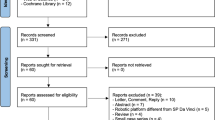Abstract
Robot-assisted radical prostatectomy (RARP) is the most commonly performed robotic procedure worldwide and is firmly established as a standard treatment option for localised prostate cancer. Part of the explanation for the rapid uptake of RARP is the reported gentler learning curve compared with the challenges of laparoscopic radical prostatectomy (LRP). However, robotic surgery is still fraught with potential difficulties and avoiding complications while on the steepest part of the learning curve is critical. Furthermore, as surgeons progress there is a tendency to take on increasingly complex cases, including patients with difficult anatomy and prior surgery, and these cases present a unique challenge. Significant intra-abdominal adhesions may be identified following open surgery, or dense periprostatic inflammation may be encountered following TURP; large prostate gland size and median lobes may alter bladder neck anatomy, making difficult subsequent urethro-vesical anastomosis. Even experienced robotic surgeons will be challenged by salvage RARP. Approaching these problems in a structured manner allows many of the problems to be overcome. We discuss some of the specific techniques to deal with these potential difficulties and highlight ways to avoid making serious mistakes.
This is a preview of subscription content, access via your institution
Access options
Subscribe to this journal
Receive 4 print issues and online access
$259.00 per year
only $64.75 per issue
Buy this article
- Purchase on Springer Link
- Instant access to full article PDF
Prices may be subject to local taxes which are calculated during checkout
Similar content being viewed by others
References
Vickers A, Savage C, Bianco F, Mulhall J, Sandhu J, Guillonneau B et al. Cancer control and functional outcomes after radical prostatectomy as markers of surgical quality: analysis of heterogeneity between surgeons at a single cancer center. Eur Urol 2011; 59: 317–322.
Rashid HH, Leung YYM, Rashid MJ, Oleyourryk G, Valvo JR, Eichel L . Robotic surgical education: a systematic approach to training urology residents to perform robotic-assisted laparoscopic radical prostatectomy. Urology 2006; 68: 75–79.
Zorn CK, Gautam G, Shalhav AL, Clayman RV, Ahlering TE, Albala DM et al. Training, credentialing, proctoring and medicolegal risks of robotic urological surgery: recommendations of the society of urologic robotic surgeons. J Urol 2009; 182: 1126–1131.
Herron DM, Marohn M, SAGES-MIRA Robotic Surgery Consensus Group. A consensus on robotic surgery. Surg Endosc 2008; 22: 313–325.
Goldstraw MA, Patil K, Anderson C, Dasgupta P, Kirby RS . A selected review and personal experience with robotic prostatectomy: implications for adoption of this new technology in the United Kingdom. Prostate Cancer Prostatic Dis 2007; 10: 242–249.
Atug F, Castle EP, Srivastav SK, Burgess SV, Thomas R, Davis R . Positive surgical margins in robotic-assisted radical prostatectomy: impact of learning curve on oncological outcomes. Eur Urol 2006; 49: 866–872.
Ahlering TE, Skarecky D, Lee D, Clayman RV . Successful transfer of open surgical skills to a laparoscopic environment using a robotic interface: initial experience with laparoscopic radical prostatectomy. J Urol 2003; 170: 1738–1741.
Murphy DG, Bjartell A, Ficarra V, Graefen M, Haese A, Montironi R et al. Downsides of Robot-assisted Laparoscopic Radical Prostatectomy: Limitations and Complications. Eur Urol 2010; 57: 735–746.
Zorn KC, Wille MA, Thong AE, Katz MH, Shikanov SA, Razmaria A et al. Continued improvement of perioperative, pathological and continence outcomes during 700 robot-assisted radical prostatectomies. Can J Urol 2009; 16: 4742–4749.
Doumerc N, Yuen C, Savdie R, Rahman MB, Rasiah KK, Pe Benito R et al. Should experienced open prostatic surgeons convert to robotic surgery? The real learning curve for one surgeon over 3 years. BJU Int 2010; 106: 378–384.
Schwartz BF . Training requirements and credentialing for laparoscopic and robotic surgery--what are our responsibilities? J Urol 2009; 182: 828–829.
Lavery HJ, Thaly R, Albala D, Ahlering T, Shalhav A, Lee D et al. Robotic equipment malfunction during robotic prostatectomy: a multi-institutional study. J Endourol 2008; 22: 2165–2168.
Murphy D, Challacombe B, Elhage O, Dasgupta P . Complications in robotic urological surgery. Minerva Urol Nefrol 2007; 59: 191–198.
World Health Organisation Surgical Safety Checklist. National Patient Safety agency Ref: 0861. Jan 2009.
Mayer EK, Winkler MH, Aggarwal R, Karim O, Ogden C, Hrouda D et al. Robotic prostatectomy: the first UK experience. Int J Med Robot 2006; 2: 321–328.
Rosevear HM, Lightfoot AJ, Zahs M, Waxman SW, Winfield HN . Lessons learned from a case of calf compartment syndrome after robot-assisted laparoscopic prostatectomy. J Endourol 2010; 24: 1597–1601.
Palese MA, Munver R, Phillips CK, Dinlenc C, Stifelman M, DelPizzo JJ . Robot-assisted laparoscopic dismembered pyeloplasty. JSLS 2005; 9: 252–257.
de Menezes Ettinger JE, dos Santos Filho PV, Azaro E . Prevention of rhabdomyolysis in bariatric surgery. Obes Surg 2005; 15: 874–879.
Shaikh S, Nabi G, McClinton S . Risk factors and prevention of rhabdomyolysis after lap nephrectomy. BJU Int 2006; 98: 960–962.
Lee KL, Hsu TH . Physiologic response to laparoscopic surgery: practical considerations. Contemp Urol 2004; 16: 36–45.
Meininger D, Westphal K, Bremerich DH, Runkel H, Probst M, Zwissler B et al. Effects of posture and prolonged pneumoperitoneum on hemodynamic parameters during laparoscopy. World J Surg 2008; 32: 1400–1405.
Phong S, Koh L . Anaesthesia for robotic radical prostatectomy: considerations for laparoscopy in Trendelenburg position. Anaesth Intensive Care 2007; 35: 281–285.
Chang CH, Lee HK, Nam SH . The displacement of the tracheal tube during robot-assisted radical prostatectomy. Eur J Anaesthesiol 2010; 27: 478–480.
Carey RI, Leveillee RJ . Patient positioning for robotic urologic procedures. In: Patel VR (ed). Robotic Urologic Surgery. Springer: London, 2007, pp 61–66.
Cestari A, Buffi NM, Scapaticci E, Lughezzani G, Salonia A, Briganti A et al. Simplifying patient positioning and port placement during robotic-assisted laparoscopic prostatectomy. Eur Urol 2010; 57: 530–533.
Dunne N, Booth M, Dehn T . Establishing pneumoperitoneum: Verres or Hasson? The debate continues. Ann R Coll Surg Engl 2011; 93: 22–24.
Gibson B, Abaza R . Robotic repair of access-related aortic injuries: unexpected complication of robot-assisted prostatectomy. J Endourol 2011; 25: 235–238.
Van Appledorn S, Bouchier-Hayes D, Agarwal D, Costello AJ . Robotic laparoscopic radical prostatectomy: setup and procedural techniques after 150 cases. Urology 2006; 67: 364–367.
Hemal AK, Eun D, Tewari A, Menon M . Nuances in the optimum placement of ports in pelvic and upper urinary tract surgery using the da Vinci robot. Urol Clin N Am 2004; 31: 683–692.
Siddiqui SA, Krane LS, Bhandari A, Patel MN, Rogers CG, Stricker H et al. The impact of previous inguinal or abdominal surgery on outcomes after robotic radical prostatectomy. Urology 2010; 75: 1079–1082.
Cook H, Afzal N, Cornaby AJ . Laparoscopic hernia repairs may make subsequent radical retropubic more hazardous. BJU Int 2003; 91: 729.
Cooperberg MR, Downs TM, Carroll PR . Radical retropubic prostatectomy frustrated by prior laparoscopic mesh herniorrhaph. Surgery 2004; 135: 452–453.
Laungani RG, Kaul S, Muhletaler F, Badani KK, Peabody J, Menon M . Impact of previous inguinal hernia repair on transperitoneal robotic prostatectomy. Can J Urol 2007; 14: 3635–3639.
Stolzenburg JU, Anderson C, Rabenalt R, Do M, Ho K, Truss MC . Endoscopic extraperitoneal radical prostatectomy in patients with prostate cancer and previous laparoscopic inguinal mesh placement for hernia repair. World J Urol 2005; 23: 295–299.
Pettus JA, Masterson T, Sokol A, Cronin AM, Savage C, Sandhu JS et al. Prostate size is associated with surgical difficulty but not functional outcome at 1 year after radical prostatectomy. J Urol 2009; 182: 949–955.
Martínez CH, Chalasani V, Lim D, Nott L, Al-Bareeq RJ, Wignall GR et al. Effect of prostate gland size on the learning curve for robot-assisted laparoscopic radical prostatectomy: does size matter initially? J Endourol 2010; 24: 261–266.
Link BA, Nelson R, Josephson DY, Yoshida JS, Crocitto LE, Kawachi MH et al. The impact of gland weight in robot assisted laparoscopic radical prostatectomy. J Urol 2008; 180: 928–932.
Tewari AK, Rao SR . Anatomical foundations ans surgical manoeuvres for precise identification of the prostatovesical junction during robotic radical prostatectomy. BJU Int 2006; 98: 833–837.
Menon M, Hemal AK, Tewari A, Shrivastava A, Bhandari A . The technique of apical dissection of the prostate and urthrovesical anastamosis in robotic radical prostatectomy. BJU Int 2004; 93: 715–719.
Rehman J, Chughtai B, Guru K, Shabsigh R, Samadi DB . Management of an enlarged median lobe with ureteral orifices at the margin of bladder neck during robotic-assisted laparoscopic prostatectomy. Can J Urol 2009; 16: 4490–4494.
Meeks JJ, Zhao L, Greco KA, Macejko A, Nadler RB . Impact of prostate median lobe anatomy on robotic-assisted laparoscopic prostatectomy. Urology 2009; 73: 323–327.
Murphy DG, Agarwal D, Costello AJ . Anterior retraction of the prostate during robotic-assisted laparoscopic radical prostatectomy using the closure device. BJU Int 2009; 103: 558–562.
El Douaihy Y, Tan GY, Dorsey PJ, Jhaveri JK, Tewari AK . Double-pigtail stenting of the ureters: technique for securing the ureteral orifices during robot-assisted radical prostatectomy for large median lobes. J Endourol 2009; 23: 1975–1977.
Mason BM, Hakimi AA, Faleck D, Chernyak V, Rozenblitt A, Ghavamian R . The role of endo-rectal magnetic resonance imaging in predicting difficulty for robotic prostatectomy. Urology 2010; 76: 1130–1135.
Do M, Haefner T, Liatsikos E, Kallidonis P, Hicks J, Dietel A et al. Endoscopic extraperitoneal radical prostatectomy after previous transurethral resection of prostate: oncologic and functional outcomes of 100 cases. Urology 2010; 75: 1348–1352.
Stolzenburg JU, Rabenalt R, Do M, Kallidonis P, Liatsikos EN . Endoscopic extraperitoneal radical prostatectomy: the University of Leipzig experience of 2000 cases. J Endourol 2008; 22: 2319–2325.
Jaffe J, Stakhovsky O, Cathelineau X, Barret E, Vallancien G, Rozet F . Surgical outcomes for men undergoing laparoscopic radical prostatectomy after transurethral resection of the prostate. J Urol 2007; 178: 483–487.
Hampton L, Nelson RA, Satterthwaite R, Wilson T, Crocitto L . Patients with prior TURP undergoing robot-assisted laparoscopic radical prostatectomy have higher positive surgical margin rates. J Robotic Surg 2008; 2: 213–216.
Colombo R, Naspro R, Salonia A, Montorsi F, Raber M, Suardi N et al. Radical prostatectomy after previous prostate surgery: clinical and functional outcomes. J Urol 2006; 176: 2459–2463.
Eden CG, Richards AJ, Ooi J, Moon DA, Laczko I . Previous bladder outlet surgery does not affect medium-term outcomes after laparoscopic radical prostatectomy. BJU Int 2007; 99: 399–402.
Menard J, de la Taille A, Hoznek A, Allory Y, Vordos D, Yiou R et al. Laparoscopic radical prostatectomy after transurethral resection of the prostate: surgical and functional outcomes. Urology 2008; 72: 593–597.
Jamal K, Challacombe B, Elhage O, Popert R, Kirby R, Dasgupta P . Successful salvage robotic-assisted radical prostatectomy after external beam radiotherapy failure. Urology 2008; 72: 1356–1358.
Boris RS, Bhandari A, Krane LS, Eun D, Kaul S, Peabody JO . Salvage robotic-assisted radical prostatectomy: initial results and early report of outcomes. BJU Int 2009; 103: 952–956.
Eandi JA, Link BA, Nelson RA, Josephson DY, Lau C, Kawachi MH et al. Robotic assisted laparoscopic salvage prostatectomy for radiation resistant prostate cancer. J Urol 2010; 183: 133–137.
Vallancien G, Gupta R, Cathelineau X, Baumert H, Rozet F . Initial results of salvage laparoscopic radical prostatectomy after radiation failure. J Urol 2003; 170: 1838–1840.
Author information
Authors and Affiliations
Corresponding author
Ethics declarations
Competing interests
The authors declare no conflict of interest.
Rights and permissions
About this article
Cite this article
Goldstraw, M., Challacombe, B., Patil, K. et al. Overcoming the challenges of robot-assisted radical prostatectomy. Prostate Cancer Prostatic Dis 15, 1–7 (2012). https://doi.org/10.1038/pcan.2011.37
Received:
Revised:
Accepted:
Published:
Issue Date:
DOI: https://doi.org/10.1038/pcan.2011.37
Keywords
This article is cited by
-
Human visual explanations mitigate bias in AI-based assessment of surgeon skills
npj Digital Medicine (2023)
-
Salvage robotic prostatectomy and high risk disease: what else can we do?
Journal of Robotic Surgery (2018)
-
Transurethral marking incision of the bladder neck: a helpful technique in robot-assisted laparoscopic radical prostatectomy involving post-transurethral resection of the prostate and cancers protruding into the bladder neck
BMC Urology (2013)
-
Robot-assisted laparoscopic prostatectomy and previous surgical history: a multidisciplinary approach
Journal of Robotic Surgery (2013)



